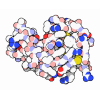+ データを開く
データを開く
- 基本情報
基本情報
| 登録情報 | データベース: PDB / ID: 1lz8 | ||||||
|---|---|---|---|---|---|---|---|
| タイトル | LYSOZYME PHASED ON ANOMALOUS SIGNAL OF SULFURS AND CHLORINES | ||||||
 要素 要素 | PROTEIN (LYSOZYME) | ||||||
 キーワード キーワード | HYDROLASE / O-GLYCOSYL / GLYCOSIDASE | ||||||
| 機能・相同性 |  機能・相同性情報 機能・相同性情報Lactose synthesis / Antimicrobial peptides / Neutrophil degranulation / beta-N-acetylglucosaminidase activity / cell wall macromolecule catabolic process / lysozyme / lysozyme activity / defense response to Gram-negative bacterium / killing of cells of another organism / defense response to Gram-positive bacterium ...Lactose synthesis / Antimicrobial peptides / Neutrophil degranulation / beta-N-acetylglucosaminidase activity / cell wall macromolecule catabolic process / lysozyme / lysozyme activity / defense response to Gram-negative bacterium / killing of cells of another organism / defense response to Gram-positive bacterium / defense response to bacterium / endoplasmic reticulum / extracellular space / identical protein binding / cytoplasm 類似検索 - 分子機能 | ||||||
| 生物種 |  | ||||||
| 手法 |  X線回折 / X線回折 /  シンクロトロン / シンクロトロン /  分子置換 / 解像度: 1.53 Å 分子置換 / 解像度: 1.53 Å | ||||||
 データ登録者 データ登録者 | Dauter, Z. / Dauter, M. / De La Fortelle, E. / Bricogne, G. / Sheldrick, G.M. | ||||||
 引用 引用 |  ジャーナル: J.Mol.Biol. / 年: 1999 ジャーナル: J.Mol.Biol. / 年: 1999タイトル: Can anomalous signal of sulfur become a tool for solving protein crystal structures? 著者: Dauter, Z. / Dauter, M. / de La Fortelle, E. / Bricogne, G. / Sheldrick, G.M. | ||||||
| 履歴 |
|
- 構造の表示
構造の表示
| 構造ビューア | 分子:  Molmil Molmil Jmol/JSmol Jmol/JSmol |
|---|
- ダウンロードとリンク
ダウンロードとリンク
- ダウンロード
ダウンロード
| PDBx/mmCIF形式 |  1lz8.cif.gz 1lz8.cif.gz | 44.7 KB | 表示 |  PDBx/mmCIF形式 PDBx/mmCIF形式 |
|---|---|---|---|---|
| PDB形式 |  pdb1lz8.ent.gz pdb1lz8.ent.gz | 30.2 KB | 表示 |  PDB形式 PDB形式 |
| PDBx/mmJSON形式 |  1lz8.json.gz 1lz8.json.gz | ツリー表示 |  PDBx/mmJSON形式 PDBx/mmJSON形式 | |
| その他 |  その他のダウンロード その他のダウンロード |
-検証レポート
| 文書・要旨 |  1lz8_validation.pdf.gz 1lz8_validation.pdf.gz | 429.7 KB | 表示 |  wwPDB検証レポート wwPDB検証レポート |
|---|---|---|---|---|
| 文書・詳細版 |  1lz8_full_validation.pdf.gz 1lz8_full_validation.pdf.gz | 434.1 KB | 表示 | |
| XML形式データ |  1lz8_validation.xml.gz 1lz8_validation.xml.gz | 10.5 KB | 表示 | |
| CIF形式データ |  1lz8_validation.cif.gz 1lz8_validation.cif.gz | 15.3 KB | 表示 | |
| アーカイブディレクトリ |  https://data.pdbj.org/pub/pdb/validation_reports/lz/1lz8 https://data.pdbj.org/pub/pdb/validation_reports/lz/1lz8 ftp://data.pdbj.org/pub/pdb/validation_reports/lz/1lz8 ftp://data.pdbj.org/pub/pdb/validation_reports/lz/1lz8 | HTTPS FTP |
-関連構造データ
| 関連構造データ | 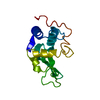 8lyzS S: 精密化の開始モデル |
|---|---|
| 類似構造データ |
- リンク
リンク
- 集合体
集合体
| 登録構造単位 | 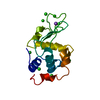
| ||||||||
|---|---|---|---|---|---|---|---|---|---|
| 1 |
| ||||||||
| 単位格子 |
|
- 要素
要素
| #1: タンパク質 | 分子量: 14331.160 Da / 分子数: 1 / 由来タイプ: 天然 / 詳細: 8 CHLORIDE AND 1 SODIUM ION PRESENT / 由来: (天然)  | ||||||
|---|---|---|---|---|---|---|---|
| #2: 化合物 | ChemComp-CL / #3: 化合物 | ChemComp-NA / | #4: 水 | ChemComp-HOH / | Has protein modification | Y | |
-実験情報
-実験
| 実験 | 手法:  X線回折 / 使用した結晶の数: 1 X線回折 / 使用した結晶の数: 1 |
|---|
- 試料調製
試料調製
| 結晶 | マシュー密度: 2.05 Å3/Da / 溶媒含有率: 40 % | ||||||||||||||||||
|---|---|---|---|---|---|---|---|---|---|---|---|---|---|---|---|---|---|---|---|
| 結晶化 | pH: 4.6 詳細: BATCH METHOD. 20 MG/ML PROTEIN SOLUTION IN 50MM SODIUM ACETATE PH 4.6 AND 10% NACL. CRYSTALS GROWN AT ROOM TEMPERATURE. | ||||||||||||||||||
| 結晶 | *PLUS | ||||||||||||||||||
| 結晶化 | *PLUS 手法: batch method | ||||||||||||||||||
| 溶液の組成 | *PLUS
|
-データ収集
| 回折 | 平均測定温度: 120 K |
|---|---|
| 放射光源 | 由来:  シンクロトロン / サイト: シンクロトロン / サイト:  NSLS NSLS  / ビームライン: X9B / 波長: 0.927 / ビームライン: X9B / 波長: 0.927 |
| 検出器 | タイプ: MARRESEARCH / 検出器: IMAGE PLATE / 日付: 1994年12月1日 / 詳細: SEGMENTED MIRROR |
| 放射 | モノクロメーター: SILICON CRYSTAL / プロトコル: SINGLE WAVELENGTH / 単色(M)・ラウエ(L): M / 散乱光タイプ: x-ray |
| 放射波長 | 波長: 0.927 Å / 相対比: 1 |
| 反射 | 解像度: 0.92→25 Å / Num. obs: 58373 / % possible obs: 90.1 % / Observed criterion σ(I): 3 / 冗長度: 2 % / Biso Wilson estimate: 17.7 Å2 / Rmerge(I) obs: 0.028 / Rsym value: 0.028 / Net I/σ(I): 29.1 |
| 反射 シェル | 解像度: 0.93→0.94 Å / 冗長度: 2 % / Rmerge(I) obs: 0.17 / Mean I/σ(I) obs: 4.9 / Rsym value: 0.17 / % possible all: 78 |
| 反射 | *PLUS 最高解像度: 1.53 Å / 最低解像度: 60 Å / % possible obs: 100 % / Rmerge(I) obs: 0.046 |
| 反射 シェル | *PLUS 最高解像度: 1.53 Å / 最低解像度: 1.56 Å / % possible obs: 100 % / Rmerge(I) obs: 0.19 |
- 解析
解析
| ソフトウェア |
| ||||||||||||||||||||||||||||||||||||||||||||||||||||||||||||||||||||||||||||||||||||
|---|---|---|---|---|---|---|---|---|---|---|---|---|---|---|---|---|---|---|---|---|---|---|---|---|---|---|---|---|---|---|---|---|---|---|---|---|---|---|---|---|---|---|---|---|---|---|---|---|---|---|---|---|---|---|---|---|---|---|---|---|---|---|---|---|---|---|---|---|---|---|---|---|---|---|---|---|---|---|---|---|---|---|---|---|---|
| 精密化 | 構造決定の手法:  分子置換 分子置換開始モデル: PDB ENTRY 8LYZ 解像度: 1.53→25 Å / SU B: 1.753 / SU ML: 0.067 / 交差検証法: FREE R / σ(F): 0 / ESU R: 0.107 / ESU R Free: 0.128
| ||||||||||||||||||||||||||||||||||||||||||||||||||||||||||||||||||||||||||||||||||||
| 原子変位パラメータ | Biso mean: 19.6 Å2
| ||||||||||||||||||||||||||||||||||||||||||||||||||||||||||||||||||||||||||||||||||||
| 精密化ステップ | サイクル: LAST / 解像度: 1.53→25 Å
| ||||||||||||||||||||||||||||||||||||||||||||||||||||||||||||||||||||||||||||||||||||
| 拘束条件 |
| ||||||||||||||||||||||||||||||||||||||||||||||||||||||||||||||||||||||||||||||||||||
| ソフトウェア | *PLUS 名称: REFMAC / 分類: refinement | ||||||||||||||||||||||||||||||||||||||||||||||||||||||||||||||||||||||||||||||||||||
| 精密化 | *PLUS % reflection Rfree: 5 % | ||||||||||||||||||||||||||||||||||||||||||||||||||||||||||||||||||||||||||||||||||||
| 溶媒の処理 | *PLUS | ||||||||||||||||||||||||||||||||||||||||||||||||||||||||||||||||||||||||||||||||||||
| 原子変位パラメータ | *PLUS | ||||||||||||||||||||||||||||||||||||||||||||||||||||||||||||||||||||||||||||||||||||
| 拘束条件 | *PLUS
|
 ムービー
ムービー コントローラー
コントローラー



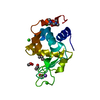
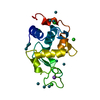
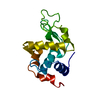
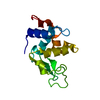
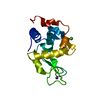

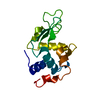
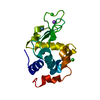

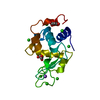
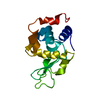
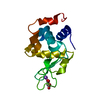
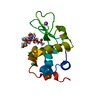
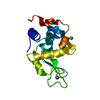


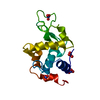
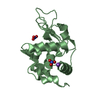
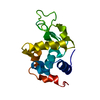
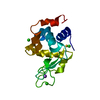
 PDBj
PDBj


